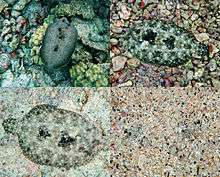Frog Skin

Frog Skin is a battledress camouflage pattern[1] with mottle and disruptive coloration to blend into the environment similar to a frog's crypsis skin.[2]
M1942 Frog Skin

The M1942 Frog Skin pattern was the United States military's first attempt at disruptive coloration camouflage.[1] In 1942, the Marine Raiders were the first issued the Frog Skin uniform, which was reversible with a five-colour jungle pattern on a green background[4] on one side and a three-colour beach pattern[5] with a tan background on the other side.[3][1][6]
Variations of Frog Skin
The United States sold the Frog Skin pattern to France who issued it to their 1st Foreign Parachute Regiment and 2nd Foreign Parachute Regiment during the First Indochina War.[7] In 1961, the Cuban exiles Brigade 2506 were issued the Frog Skin pattern by the Central Intelligence Agency (CIA) for the Bay of Pigs Invasion.[7] During the Vietnam War the United States Special Forces issued Frog Skin to the Montagnard for their guerrilla warfare activities.[7]
Similar battledress patterns
Over the years, many battledress mottle patterns have been developed by militaries around the world that are similar to the Frog Skin. The German created Flecktarn is a multi-coloured mottled pattern, which creates a dithering effect by eliminating hard colour boundaries and has been adopted by many countries. The Australian Defence Force Disruptive Pattern Camouflage Uniform is a five-colour mottle pattern, which utilizes disruptive coloration to break up a soldiers outline with a strongly contrasting design. The camouflage pattern, duck hunter marketed as hunting apparel for sportsmen was designed by a civilian, Norvell Gillespie and printed as a green and tan dominant version.[8]
References
- 1 2 3 Eastman: Frog Skin pattern Archived July 14, 2014, at the Wayback Machine.
- ↑ Exploratorium: Frogs Disappearing Act
- 1 2 The Complex Guide to Camo
- ↑ Kamouflage.net: US Jungle Camouflage
- ↑ Kamouflage: US Beach Camouflage
- ↑ US Camouflage: Frog Skin Archived November 26, 2014, at the Wayback Machine.
- 1 2 3 Toronto Standard: A Short History of Camouflage
- ↑ Camopedia: Duck Hunter
